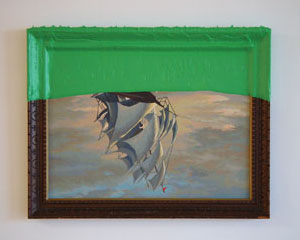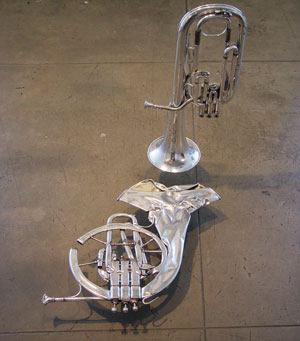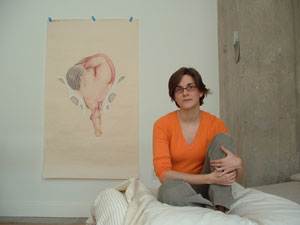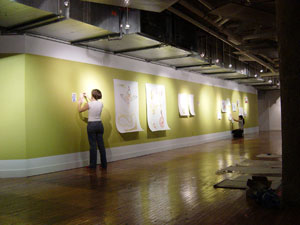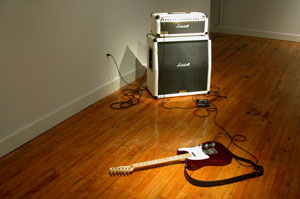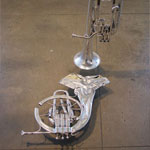To create works of provocation, one must take risks. If in that process you make life long connections personally or professionally, consider yourself lucky. If additionally, you find yourself in a beautiful loft… with a personal gallery space… that’s rent free…you probably think your dreaming. But more than likely, you are in the UTD SouthSide Artist Residency Program doing plenty of work, but learning more than you ever wanted to about facility management.
To create works of provocation, one must take risks. If in that process you make life long connections personally or professionally, consider yourself lucky. If additionally, you find yourself in a beautiful loft… with a personal gallery space… that’s rent free…you probably think your dreaming. But more than likely, you are in the UTD SouthSide Artist Residency website, developer Jack Matthews purchased the dilapidated but architecturally magnificent 1910 vintage Sears Catalog and Distribution facility in 1997 and made it into residential lofts. He chose to place studios where there were once former train track and docking areas and offer discounted rent to resident artists. In turn, SouthSide Management has been able to use this cleverly contrived cultural element in sales for the development by using phrases such as “The Art of Urban Living” on their pamphlets and touring prospective tenants through the bottom floor artist galleries. In September of 2003, Dr. Rick Brettell, UTD professor of aesthetic studies and senior adjunct curator of the Meadows Museum, was brought in to further the directive into a residency program comparable to Artpace in San Antonio, Glassell Core Program in Houston, and Chinati Foundation in Marfa. Recently, I visited the program and followed the artist’s work and activities. A month later, I found myself exhausted and inspired yet believed the program still lacked some of the administrative flow of other residencies successful in making the artists the authentic core of attention.
THE PROGRAM:The best way to really learn about the UTD SouthSide Artist Residency Program, is to talk to the residents who live and work there. The first person you will usually talk to is Karen Wiener, the on-site manager of the 2-year-old program dedicating her full and often over-time schedule to the activities and promotion of the artists. Local, national, and international artists selected for the program, now receive 1,000 square feet of studio/living space, a $1,200 per month value, free, furnished with basic appliances for 2 months to one year. The only expenses the artists incur are parking, internet connections, telephone and utility bills. Upon arrival to the residency in mid-afternoon, the artists’ lofts may seem startlingly quiet. Though all of the artists presently live and work in the spaces, most research, install, teach, lecture and perform off site during the day. In the evenings, the artists are busy experimenting and the doors are often open. There is work constantly being exhibited in the personal gallery spaces in front of each artists’ loft. These personal gallery spaces are considered the major amenity for the artists in displaying new ideas and are often where one can observe the “risk” factor in action. There is a feeling of community and professional networking that comes with being able to create a dialogue with the other artists who live only a door or two away. Former resident artist and local sculptor, Kyle Wadsworth, emphasized this asset at a recent MAC Art Talk, “The main benefit is the exposure to curators, writers and other artists.” In exchange for the free rent, the artists are expected to provide guest lectures, exhibitions, and performances at both UTD and SouthSide. Because networking is so difficult when trying to concentrate available time towards creation, Karen Weiner introduces gallery directors, critics and collectors to the artists on a regular basis through events or by appointment. A few recent visitors to the program have been; Trevor Smith, New Museum Curator; Nato Thompson, MassMoca Curator; Sue Graze, Director of Arthouse in Austin; Stephen Westfall, painter and writer for Art in America. To explore new concepts and techniques, an interdisciplinary approach on the education of materials is available by utilizing resident skill sets. Presently, there dwells talent from a variety of different disciplines. According to Karen Weiner, this variety is an intentional part of the selection process, “The selection and review process carefully evaluates applicants according to media, gallery and university affiliation, recommendations, experience at other residencies, etc. Most, but not all, are postgraduates. Our goal is to avoid having the usual suspects, to have a rich mixture with some wild cards in the bunch.”
THE ARTISTS, SPACE, and WORKS: The resident artists are the ones who live daily with the traffic of the SouthSide complex and have their own perspectives on this growing program. Baseera Khan, is one of the first artists I met during the recent Gallery Walk in late February. She is presently a gallery assistant at UNT. Khan’s gallery was filled with politically charged examples using layering techniques of photographic transfers on wood, drawings, and cutouts which convey conflict within areas of identity and culture. Known to have carried a giant faux grenade on her back in response to the overwhelming racial backlash post 9-11, her works are still veined in subtle commentary but are now smaller pieces on paper with “implications to Texas landscape” and the general intrigue of dissonance. While asking about possible influences of geography or the almost intimidatingly sophisticated SouthSide space, she claims that even by the building, “My past work had been more minimal in my use of mostly black and white. But this all natural architecture has influenced me in my use of color…I now use the same color in different mediums”. Ryan Fitzer received his MFA in Ceramics from SMU and is presently Gallery Director and teacher at Mountain View College. He is able to use his kiln on-site but noted that he is presently experimenting with newer mediums in organically shaped foam forms caste from rubber molds. These experiments were recently installed into the actual wall of the 3000 sq. ft., sohoesque, Janette Kennedy Gallery at SouthSide. Fitzer lives in the space formerly occupied by Kyle Wadsworth and comments about the seeming fraternal influence of the program, “I have talked with both Wadsworth and Chris Jagers and learned a lot from them about the business of art and criticism. ”
Another thing learned is that size matters when it comes to large paintings or sculptures having to fit through the standard sized 3 ft. doors of the living spaces. Brian Fridge is presently building architectural structures within his front gallery space to accompany his videos in attempts to “recontextualize” earlier works. Fridge creates pieces to operate within a space so fortunately, its dismantling will be of less consequence. Brian has been at Artpace and included in the Whitney Biennial and as far as comparisons go, commented, “A great amount of latitude is given to me here. I have had as good an experience here as I have had at ArtPace. Just different”. At the end of the hall is the studio of Saskia Jorda, a native of Venezuela, but long time resident of NYC. Her studio, best shows the abundance of natural light emanating throughout many of the spaces. In contrast to her usual experience of having constant stimuli from bustling NYC as soon as exiting her home, Dallas seems all sky. She immediately observed that one can go without running into a human for hours. Whether isolation or peace, it is this combination that has helped create such smoothly sensual drawings. Surprisingly inspired by old science books illustrating organisms such as butterfly genitalia or troubled pregnancies, these issues of metanoia and metamorphosis communicated by her delicate lead work are very intimately revealed by these glowing studio conditions.
However, the measure of space among writers or performers and artists producing actual physical structures is something that is not well distributed. This could be due to the staggered dates of entry into the program. Shin Yu Pai received her MFA from The School of the Art Institute of Chicago and is teaching at SMU. She has already published several collections of poetry with her most recent work Unnecessary Roughness (xPress,2005) a collection of impressions from the dark side of organized sports. Writers like Shin Yu and sound-related media artists are being given opportunities to perform as part of the SouthSide visual art openings. Even with the generous layout of an elegant reading mat in her personal gallery, Shin Yu has twice the space that the visual artists have. On the other hand, Photographer Misty Keasler could fantastically fill twice that of even the Janette Kennedy Gallery. She is represented by Photographs Do Not Bend, recently exhibited at Women and Their Work in Austin, and was recently awarded the Lange-Taylor Prize from the Center for Documentary Studies at Duke University for her documentation of the Guatemala City Dump. Her studio space contained scenes from Russian Orphanages. My favorite collection, were scenes of her family, which vividly illustrate that East Texas can be as exotic as anything over the border. Keasler has a practical nature concerning some of her more dangerous assignments. On her trip to Guatemala, she had been warned that she would probably get robbed. Her solution was simply to bring “double the equipment”. Fear seems a necessary part of her process and yet, nothing to be afraid of. Keasler uses the space as home base and to visualize how the work will eventually exhibit.
In spite of the artists’ gratitude for the many opportunities the residency offers, there are still facility issues within the program. The artists can either have or share online services or supply their own technical needs as most normal residents would. Though presently lacking a materials stipend, facilities such as darkrooms or woodshops are available at the UTD campus. Unfortunately, UTD is quite a distance from SouthSide and not directly on the Dart Line. For those artists unfamiliar to Dallas or without transportation, this can be a major obstacle. These setbacks don’t seem to bother Stephen Lapthisophon, who even with a vision disability, seems to produce while remaining unaffected by the limits or luxuries the space offers. Visiting from Chicago, Lapthisophon’s large paintings are presently being exhibited at Conduit Gallery. Unlike some of the younger artists, Lapthisophon has not needed the SouthSide Gallery space with his recent installations having been hosted by the MAC and IR Gallery.
The SouthSide Management team controls the Janette Kennedy Gallery and uses it for community related events. However, the scheduling of one of these events, recently forced the residency artists to manually change their already printed, albeit program-sponsored, invitations, in order to fit in an additional exhibit on motorcycles. Because of some of these community events, the resident artists exhibits are less than 2 weeks long. This is barely long enough for a critic to review the show or time to allow significant attendance. Fortunately, the closing reception for Art Show Here had an unusually high mid-week head count, with a pulsing opening performance by Paul Slocum’s Treewave Music Project, video by Brian Fridge, new plastic sculpture by Angstrom Gallery artist and local educator Titus O’Brien, and the growth-like wall protrusions of Ryan Fitzer. Artists in any residency, especially one where they are surrounded by high-end loft standards offered up in benevolence, are often subject to feeling like they need to stay humble for fear the program would become too much trouble. Any fledgling program will come across its obstacles. However irritating, some of these space related issues are treatable with a bit of management genius and the foundation of a good donor program that is starting to see strong support.
These facility issues are minor in contrast to the influence that the residency has had on the ongoing careers of past residents. Kyle Wadsworth is presently part of the McKinney Avenue Contemporary’s TWANG exhibition in Dallas. Ludwig Schwarz, regularly shows at Angstrom and is a finalist for the Arthouse Texas Prize. Chris Jagers was part of the Dallas Contemporary’s Painting Attack, is presently exhibiting a series of prints at Brookhaven’s Forum Gallery. Sai Selvarajan shot a 16mm short film that was commissioned by KERA and has been shown internationally. Annie Murdock is now in New York looking forward to performing The Prayer Project at EXIT Art. Kelli Connell is an Assistant Professor of Photography living and working in Ohio. She will be exhibiting in a solo show at Barry Whistler next month, later at Galveston Art Center and solo at ClampArt in NYC later this fall.
LEARNING FROM EXPERIENCE: Of the 4 Texas residencies, the UTD SouthSide Program is the youngest. The Chinati Foundation in Marfa has been active since 1989, ArtPace in San Antonio since 1994, and the MFAH Glassel CORE Program since 1982. Each program has a specific amount of time and number of applicants per year and offer a predetermined amount of space, time and/or stipend for materials. As is typical with the arts these days, all the programs rely on public/private generosity. Libbey Tilley of Art Pace, described their fundraising efforts as a “multi-level approach from individuals, government agencies, foundations, and corporations”. A significant difference between the other programs and UTD SouthSide is found in two areas; selection and staffing. While the other programs invite outside curators or panelists to come and pick each round of new artists, Dr. Brettell is presently picking the residents for UTD SouthSide. Part of the problem with this scenario is that as evolved as he is, this sacred “variety” will eventually be limited to the experiences and opinions of one person. Additional staffing is the key solution. Dr. Brettell is in high demand on numerous projects and Karen Weiner, though dynamically efficient, cannot be cloned. In addition to the generosity of the developer, Jack Matthews, in offering up this grand space, funding and continued open dialogue between the residency and facility management will help UTD SouthSide overcome some of these “growing pains”.
Since the programs inception, it has housed 24 artists and held 50 events. It is evident that the artists are inspiring and supporting each other, the arts community, and the community at large through education and example. The individual artists and their works can be seen and heard all over the city and country on a weekly basis. There are over 70 similar residency programs throughout the U.S.-though only 4 exist in Texas. The UTD SouthSide Artist Residency is already an invaluable asset to the city of Dallas and in spite of early challenges, is proving its worth as one of Texas’ stronger art resideny programs.


